Abstract
Stiffness of ankle joint has been investigated in a wide range of biomechanical studies with a focus on the improvement of performance and reduction in the risk of injury. However, measuring ankle joint stiffness (AJS) using the existing conventional methodologies requires sophisticated equipment such as force plate and motion analyses systems. This study presents a novel method for measuring AJS during a hopping task with no force or motion measurement system. Also the validity of the proposed new method was investigated by comparing the results against those obtained using conventional method in which motion capture and force plate data are used. Twelve participants performed the controlled hopping task at 2.2 Hz, on a force platform, and six high speed cameras recorded the movement. To calculate the AJS in both methods, the lower extremity was modeled as a three linked rigid segments robot with three joints. In the new method, the contact time and flight time were used to calculate ground reaction force, and inverse kinematic and inverse dynamic approaches were used to calculate the ankle kinematic and kinetic. The AJS calculated using the new method was compared against the results of conventional method as the reference. The calculated AJS using this new method (506.47 ± 177.84 N·m/rad) showed a significant correlation (r = 0.752) with the AJS calculated using conventional method (642.39 ± 185.96 N·m/rad). The validation test showed a mean difference of −24.76% using Bland–Altman plot. The presented method can be used as a valid, and low-cost tool for assessing AJS in the field in low resource settings.
1. Introduction
Stiffness is one of the mechanical properties of viscoelastic structures, which is a measure of their resistance to deformation [1,2]. Joint stiffness defines as a resistance produced by muscles, tendons, and ligaments across the joint, which is a respond to the joint net moment [3]. Joint stiffness is presented as slope of moment-angular displacement diagram at the joint [4,5,6,7]. The torsional spring has been used to calculate joint stiffness in some tasks such as hopping [3]. This model deconstructs the lower limb into three torsional springs—the ankle, knee, and hip and uses the kinematic and ground reaction force data to calculate the joint moments and angles [3].
In laboratory conditions, as mentioned in the Serpell et al. review paper in 2012 [8], ankle and knee joints stiffness is usually measured in hopping, jumping, or running by means of force plates and the motion analysis system with high speed cameras and through a common formulation. In this common formula, joint stiffness obtained by dividing joint moment to angular displacement [5]. In this conventional method, the angle changes and other kinematic data obtained from motion analysis system and the joint moment calculated using the ground reaction force measured using a force plate through the inverse dynamic method.
Using this conventional method, higher reliability in calculating the stiffness in ankle joint compared to knee joint was reported in hopping test [3,4,9]. A review of such models that were developed based on motion analyses and the measurement of ground reaction force indicated an appropriate reliability for: leg stiffness, the ratio of maximal ground reaction force to vertical displacement of center of mass during contact time, and AJS but an inappropriate reliability for knee joint stiffness while hopping [10]. Additionally, strong correlation was reported between the leg stiffness and ankle joint stiffness in hopping [9] when using the conventional method of calculating ankle joint stiffness.
Stiffness of the ankle joint calculated using the conventional method has been considered in wide range of studies such as: comparison of AJS in healthy vs. pathological participants [11,12], the influence of AJS on sport performance [10,13,14,15,16], the role of AJS on the assessment of risk of lower extremity injury [16,17], the reliability of measuring AJS [10,17,18], comparison of the different methods of measuring AJS [8,19], and comparison of leg stiffness against AJS [17]. In addition, AJS calculated using conventional method was used to: compare the variation in AJS with increase in running speed [20], compare the AJS between sprint and endurance athletes during a variety of hopping and drop jump tasks [21], assess the performance between endurance trained athletes and participants from the general population during a maximal hopping test [22], investigate the effect of foot strike and shoe features on ankle joint stiffness [23], and investigate the effects of training on AJS [24]. Hence the previous studies have expressed that AJS could be helpful in the assessment of human locomotion.
Despite the wide range of applications for the leg stiffness, its calculation through conventional methods needs access to motion analyses and the measurement of ground reaction force using force plate that are not commonly available in low-resource settings. Additionally, the conventional method is restricted to lab environment where the force plate and motion capture devices are commonly available.
To overcome that limitation, in 2004, a simple method was introduced and validated by Dalleau [25], which could calculate the leg stiffness in hopping and bouncing with a simple set of technical equipment and under field condition. In this method, the vertical ground reaction force was modeled as a sine wave which is a function of contact and flight times and the leg stiffness was calculated using a simple contact mat. This showed a significant correlation (r = 0.94) between the leg stiffness calculated with this method against the conventional method. Despite this success, the model developed by Dalleau [25] could not calculate the stiffness of the ankle as an important joint in the lower extremity.
As it stands currently, to calculate ankle joint stiffness, only conventional methods of calculating joint stiffness exist in which access to the motion analyses and measurements of ground reaction force are necessary. Therefore, this study aimed to develop a simple method for calculating the ankle joint stiffness (AJS), without a need for motion analyses and measurements of ground reaction force. Upon development, this can have implications in assessing the AJS in the field in low resource settings where access to sophisticated equipment is not available.
2. Materials and Methods
2.1. Participants, Procedures, and Equipment
Twelve male participants (mean ± SD age of 23.33 ± 3.23 year; mass 77.04 ± 12.56 kg; height 174.46 ± 7.16 cm;) gave their informed, written consent to participate in this study, following the approval by the research ethics committee of the University of Tehran (IR.UT.SPORT.REC.1397.019). Four reflective markers, as shown in Figure 1, were placed on greater trochanter (GT), lateral femoral epicondyle (LFE), lateral malleolus (LM), and the fifth metatarsophalangeal joint (5thMTP). The length of thigh (distance between GT and LFE), shank (distance between LFE and LM), and foot (distance between LM and 5thMTP) were measured. After walking five minutes, as a warm-up, each participant performed two-legged continuous vertical controlled hops (without shoes and keeping hands on the waist) with frequency of 2.2 Hz [26] that was controlled through synchronization with a metronome. Each participant then performed 15 hops continuously in each trial and repeated it for three times, (data of the five middle hops in each trial were used). The hops were performed on a force platform (AMTI, Watertown, NY, USA; 1000 Hz) and a motion analysis system (Motion Analysis Co., Rohnert Park, CA, USA; 200 Hz) with six high speed cameras recorded the movement. Kinematic and ground reaction force data obtained after post processing (filling gaps, smoothing, filtering) via Cortex software.
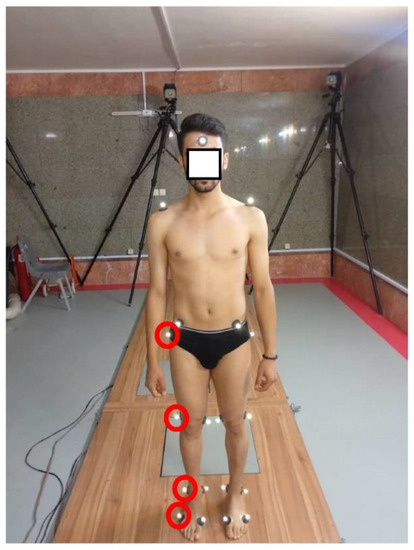
Figure 1.
The placement four reflective markers at the legs are shown.
2.2. Calculating AJS Using New Method
In this method, lower extremity was modeled as a three linked rigid segments (including thigh, shank, and foot) robot as a two-dimensional hopping model in the sagittal plane. The segments were interconnected with three torsional springs as three torsional frictionless hinge joints, one between thigh and shank (knee), the other between shank and foot (ankle), and the third one between the fifth metatarsophalangeal and the floor (only the contact phase of hopping was analyzed). These springs represented the action of the muscles, tendons, and ligaments across the joint. The hip was considered as the end effector of the robot and assumed that the total body mass was concentrated on it. The hip was assumed to follow a periodic vertical displacement (sinusoidal wave) during hopping based on which joints kinematics were calculated using inverse kinematics method. However, this assumption excluded some movement in horizontal plane that happens which may be considered as a limitation for this model.
To determine the position and orientation of each limb related to other limbs, the Denavit–Hartenberg (D-H) method was used [27]. This model and the coordinate systems are illustrated in Figure 2.

Figure 2.
Model of lower extremity and the coordinate systems.
In this method (Figure 3), to find the angles at knee and ankle, an inverse kinematic problem was solved. In first step, the reference frame transition matrixes were calculated by direct kinematic. The matrix that converts reference frame 3 (attached to hip) to reference frame 0 (attached to metatarsal-floor connection) is
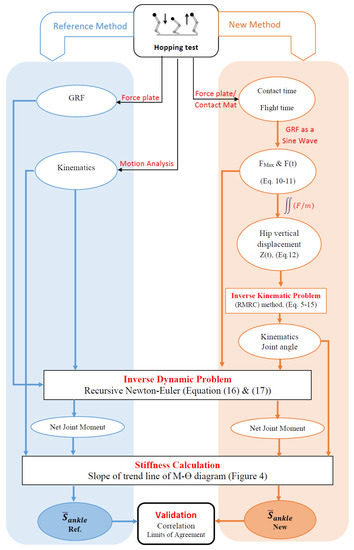
Figure 3.
The diagram showing the different approaches taken to calculate the Ankle Joint Stiffness using the new method vs the reference method.
In which
In Equations (2)–(4), and l represents joint angle and segment length respectively. To solve the inverse kinematic, the resolved motion rate control (RMRC) method was used [28]. The Jacobian matrix, that related the angles to the position of end effector, was calculated as:
In which
S123 = sin (θ1+ θ2+ θ3)
C123 = cos (θ1+ θ2+ θ3)
Because this is a redundant problem, the Pseudo inverse of Jacobian matrix should be calculated
The horizontal linear velocity of end effector (hip) supposed to be zero and its vertical linear velocity was calculated from
which is obtained of modeling ground reaction force in hopping task as a sine wave (Equations (10) and (11)), as fully detailed elsewhere [25]
which is in
In these equations, m is the mass of subject, Tc and Tf represent the contact time and flight time in hoping, g used for gravitational acceleration, and t shows the time.
By integrating the above expression of the velocity, Equation (9), vertical displacement of hip was calculated
where z (0) = 0 is the vertical position of center of mass at the time of first touch with ground.
Therefore, the linear velocity matrix of hip was obtained
In which
Angular velocities were calculated from Jacobian and linear velocity matrixes, (Equation (15)) and angular displacements were obtained by integrating the angular velocities.
To calculate the moment of joints, the inverse dynamic problem was solved with recursive Newton–Euler method [29].
In which, M and F show net moment and net force at the joints, D and P use for distal joint (fifth metatarsophalangeal joint) and proximal one (ankle joint). aG and αG represent linear and angular acceleration about center of gravity, IG uses for moment of inertia, and r and m represent distance and mass of the segment.
The algorithms of inverse kinematic and inverse dynamic were developed in MATLAB (R2018a). The stiffness of joint assumes to be constant and is calculated as changes of moment over changes of angle in the joint or the slope of linear fit to M-Ɵ diagram as shown in Figure 4 [30,31].
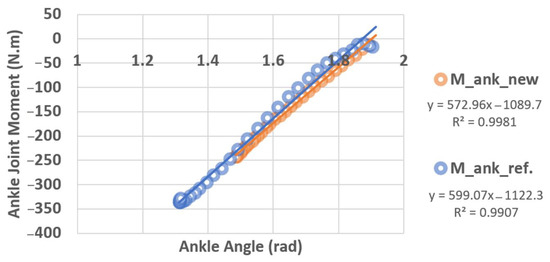
Figure 4.
Slopes of trend lines of M-Ɵ diagram.
2.3. Calculating AJS Based on Conventional (Reference) Method
As fully detailed elsewhere [17], the angle of joints were calculated from kinematic data (by entering x-z trajectories of markers in Mokka-0.6.2 software). The moment of joints were calculated by solving an inverse dynamic problem with recursive Newton–Euler method [29]. Similarly in the new method, the stiffness of ankle was calculated as slope of trend line of M-Ɵ diagram in this joint. Figure 3 shows all the steps in the two methods.
2.4. Statistics
Resulted data from both methods analyzed in SPSS22 software. Pearson correlation and Bland–Altman plot are used to test the validation of new method (α ≤ 0.05).
3. Results
3.1. Methods Output
The ankle angle, sagittal angle created between foot and shank in the model in reference method, is obtained of kinematic data which exported from motion analysis system but in new method is obtained by solving inverse kinematic. The ground reaction force in conventional method is force platform’s output but in the new method is calculated by the formula. The moment at ankle joint in both methods is calculated by solving inverse dynamics equations. Figure 3 shows a comparison of the AJS for a participant using the two methods.
Ankle joint angle and stiffness that calculated by the two methods, the conventional method and the new method, are presented in Table 1.

Table 1.
Ankle joint angle and stiffness by two methods.
The ankle angle at the middle of the contact phase and the ankle joint stiffness, for all participants are shown in Figure 5 where the angles and stiffness calculated by new method are very close, to those calculated by the conventional method for most participants.
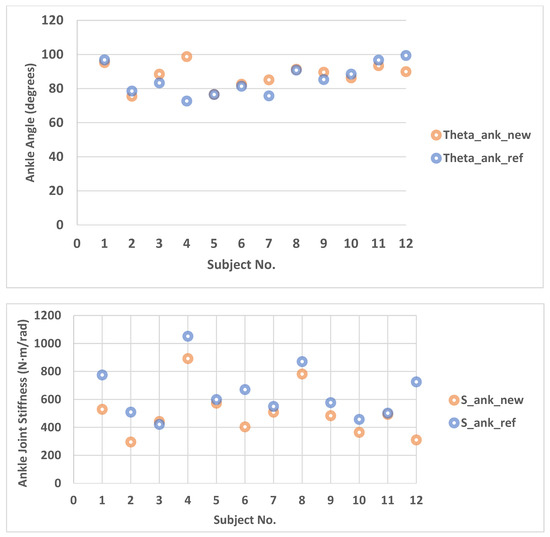
Figure 5.
Comparison between variables obtained using new method versus reference method. Ankle angle (Theta) as the angle between foot and shank (top), and ankle joint stiffness (bottom).
Some additional information about the comparison of two methods for a typical subject could be found in the Appendix A.
3.2. Validation
The normality of data was performed through Shapiro-Wilk test. Because all data were normal thus Pearson correlation test was used. There was a significant correlation between stiffness values calculated with the two methods (r = 0.752, p = 0.005).
The mean difference and limits of agreement between the new method and the reference method is displayed in Bland–Altman plots in Figure 6.

Figure 6.
Bland–Altman plots displaying the difference between joint angle (top) and joint stiffness (bottom) measured with the new method and reference method in ankle joints.
4. Discussion
The aim of this study was to introduce a novel low-cost method for measuring AJS during hopping. For this purpose, a simple method was considered to simulate GRF and CoM displacement during hopping. Furthermore, inverse kinematic method was used to estimate joint angles. In addition, ankle joint moment was calculated using inverse dynamic method. Finally, AJS was obtained as the slope of ankle joint’s moment-angular displacement data. The capability of new method to calculate AJS was different between participants, but overall there was a significant correlation (r = 0.752) between ankle stiffness obtained using the two methods.
As the proposed method is new, there is no study in literature to compare the results against. However, appropriate agreement was observed between the results of the conventional method used in this study as reference and those reported in the previous literature. The purposes of previous studies were different than this study and each of those assessed correlation or reliability of ankle joint stiffness with different factors such as leg stiffness, performance, or risks of injury. However, the method of measuring the moment and stiffness of ankle joint in hopping are similar in all of these studies, which are the same as reference method in this study. Therefore, the data extracted using the reference method in this study could be compared with previous data, where the net moment in ankle joint closely represents those reported in previous studies [4,19,32]. Also, the stiffness of ankle joint, 642.39 N·m/rad from the reference method is comparable to 433.37 N·m/rad or 553.77 N·m/rad that have been reported in the literature [17,32,33]. In a similar study proposed a simple method to calculate the leg stiffness, the results were similar to the reference method [25].
The difference between stiffness values obtained from two methods could be due to underestimation of the propulsive time in the new method, because the ground reaction force was modeled as a sine wave, it was assumed that propulsive time is half of contact time [25]. However, the propulsive time was observed to be over 50% of the contact time in experiment that was due to the asymmetry of the landing and take-off phase duration within the contact time [34]. In the inverse kinematic method, the movement of end effector assumed to be completely vertical, but the horizontal velocity is not zero in kinematic data obtained from motion analyses, which could be a cause of discrepancy compared to the actual ankle joint stiffness. Another reason for the observed differences between the AJS obtained from the proposed new method vs. those obtained from conventional methods could be the position of center of mass, which is supposed to be on the hip joint.
The method was capable of measuring ankle joint stiffness with a significant correlation with the stiffness measured using conventional method. The proposed method does not require lab equipment, such as force-plate and motion analyses systems, that makes it suitable in the field and in low resource settings.
5. Conclusions
In summary, this study presented a novel method for calculating AJS during hopping only by having contact time and flight time of a hop. The joint stiffness measurement using this method has been validated against the conventional method. The proposed method is low cost as it does not need equipment such as force plate and motion analyses systems and could be used in low resource settings and in the field where access to sophisticated equipment is limited. The proposed method could have practical implications for future studies where improving performance and reducing the risk of injury are intended.
Such methods can facilitate the investigation of the effect of exercise programs designed to manipulate the elastic properties of the soft tissues around the ankle joint specifically the Achilles tendon. Exercises include plyometric exercises that improve athletic performance by increasing energy storage, energy reproduction, and the speed of force transmission, or exercises that prevent injuries by enhancing the capacity of structures of tissues to overcome the ground reaction shocks.
The approach used in this research can be optimized by applying different conditions and can be used in simplification and analysis of many other human movements.
Author Contributions
Conceptualization, E.S. and M.A.; Methodology, S.G.F., E.S. and M.A.; Software, S.G.F.; Validation, S.G.F., E.S. and A.S.; Formal analysis, S.G.F. and M.A.; Investigation, S.G.F., E.S., A.S. and R.N.; Resources, S.G.F. and M.A.; Data curation, S.G.F. and E.S.; Writing—original draft preparation, S.G.F.; Writing—review and editing, E.S., A.S. and R.N.; Visualization, S.G.F. and E.S.; Supervision, E.S. and A.S.; Project administration, E.S. All authors have read and agreed to the published version of the manuscript.
Funding
This research received no external funding.
Institutional Review Board Statement
The study was conducted according to the guidelines of the Declaration of Helsinki, and approved by the Research Ethics Committee of the University of Tehran (Approval ID: IR.UT.SPORT.REC.1397.019, 7 October 2018).
Informed Consent Statement
Informed consent was obtained from all participants involved in the study.
Data Availability Statement
In this study, there are two series of data for all subjects (12 subjects) in format of excel files, the force plate data (kinetic data), which was used in both of reference method and the new method (to obtain contact time and flight time), and the motion analysis data (kinematic data), which is used only in reference method.
Conflicts of Interest
There is not any relationship or support which might be perceived as constituting a conflict of interest.
Nomenclature
A list of nomenclature for all abbreviations, Greek letters, symbols and letters used in this study:
| AJS | Ankle joint stiffness |
| GRF | Ground reaction force |
| GT | Greater trochanter |
| LFE | Lateral femoral epicondyle |
| LM | Lateral malleolus |
| 5thMTP | Fifth metatarsophalangeal joint |
| RMRC | Resolved motion rate control |
| LoA | Limits of agreement |
| CoM | Center of mass |
| Joint angle | |
| l | Segment length |
| J | Jacobian matrix |
| m | Mass of subject |
| Gravitational acceleration | |
| t | Time |
| Tc | Contact time |
| Tf | Flight time |
| F | Ground reaction force |
| Vertical linear velocity | |
| Linear velocity matrix | |
| z | Vertical displacement |
| Ɵ | Angular velocities |
| MP | Net moment at the proximal join |
| MD | Net moment at the distal join |
| FP | Net force at the proximal join |
| FD | Net force at the distal join |
| IG | Moment of inertia |
| aG | Linear acceleration about center of gravity |
| αG | Angular acceleration about center of gravity |
| rGP | Distance of proximal joint and center of gravity |
| rGD | Distance of distal joint and center of gravity |
| Angle of ankle | |
| M_ank_new | Net moment at ankle measured by new method |
| M_ank_ref | Net moment at ankle measured by reference method |
| Theta_ank_new | Angle of ankle measured by new method |
| Theta_ank_ref | Angle of ankle measured by reference method |
| Stiffness of ankle | |
| Stiffness of ankle measured by new method | |
| Stiffness of ankle measured by reference method | |
| deltaY_hip | Displacement of hip |
Appendix A
In the reference method, the angle of ankle obtained from motion analysis system’s data but in new method the angle of ankle obtained by solving an inverse kinematic problem. The angles of ankle measured by both methods during half of contact phase of hopping are shown in Figure A1.
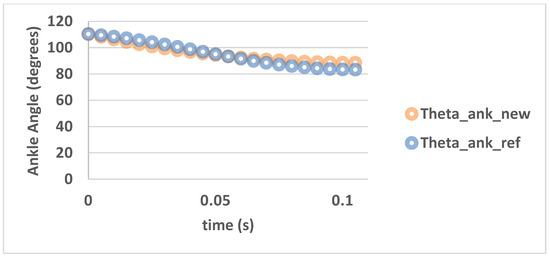
Figure A1.
Angle of ankle during half of contact phase of hopping.
In the reference method, the displacement of the hip is extracted from the motion analysis system’s data, but in the new method the displacement of hip calculated by a formulation that obtained by Dalleau in 2004. The displacements of hip measured by both methods during half of the contact phase of hopping are presented in Figure A2.
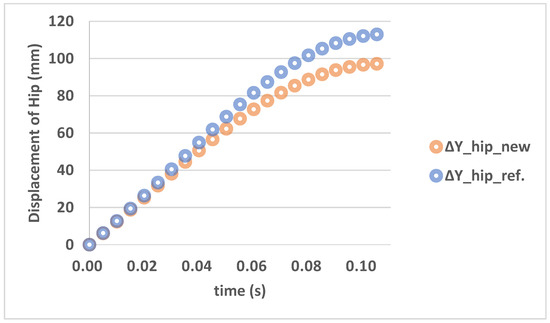
Figure A2.
Displacement of hip during half of the contact phase of hopping.
In the reference method, ground reaction force extracted from force plate’s data but in new method the ground reaction force calculated by a formulation which modeled the ground reaction force as a sine wave and obtained in 2004, by Dalleau. The ground reaction forces measured by both methods during half of the contact phase of hopping are shown in Figure A3.
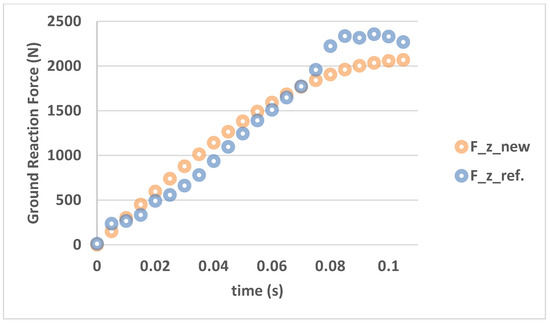
Figure A3.
Ground reaction force during half of contact phase of hopping.
The moment in the ankle joint in both methods is calculated by solving an inverse dynamic problem; but the input data for inverse dynamic problem, as presented above, is calculated by different methods, so difference in moment in the ankle join, measured by both methods during half of contact phase of hopping, are seen in Figure A4.
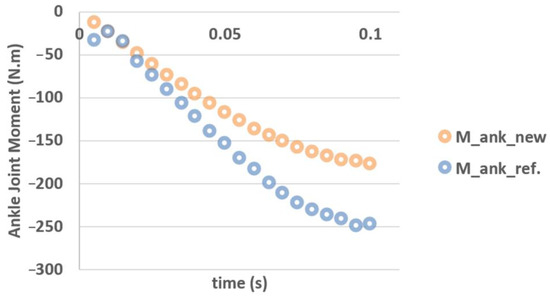
Figure A4.
Moment in the ankle joints during half of contact phase of hopping.
The stiffness of ankle joints in both methods—reference method and new method—calculated by the same formulation, but the input data for this formulation were measured by different tools. The stiffness of ankle for all participants is presented in Table A1:

Table A1.
Stiffness of ankle for 12 subjects.
Table A1.
Stiffness of ankle for 12 subjects.
| Subject No. | ||
|---|---|---|
| 1 | 775.09 | 529.39 |
| 2 | 508.92 | 295.57 |
| 3 | 421.29 | 442.55 |
| 4 | 1051.7 | 892.07 |
| 5 | 599.07 | 572.96 |
| 6 | 670.58 | 403.91 |
| 7 | 549.97 | 508.79 |
| 8 | 870.69 | 781.68 |
| 9 | 576.78 | 483.52 |
| 10 | 457.18 | 364.4 |
| 11 | 502 | 492.81 |
| 12 | 725.46 | 310.07 |
References
- Baumgart, F. Stiffness—An unknown world of mechanical science? Injury 2000, 31, 14–84. [Google Scholar]
- Latash, M.L.; Zatsiorsky, V.M. Joint stiffness: Myth or reality? Hum. Mov. Sci. 1993, 12, 653–692. [Google Scholar] [CrossRef]
- Farley, C.T.; Houdijk, H.H.P.; Strien, C.V.; Louie, M. Mechanism of leg stiffness adjustment for hopping on surfaces of different stiffnesses. J. Appl. Physiol. 1998, 85, 1044–1055. [Google Scholar] [CrossRef]
- Farley, C.T.; Morgenroth, D.C. Leg stiffness primarily depends on ankle stiffness during human hopping. J. Biomech. 1999, 32, 267–273. [Google Scholar] [CrossRef]
- Stefanyshyn, D.J.; Nigg, B.M. Dynamic Angular Stiffness of the Ankle Joint during Running and Sprinting. J. Appl. Biomech. 1998, 14, 292–299. [Google Scholar] [CrossRef] [PubMed]
- Luo, Z.; Zhang, X.; Wang, J.; Yang, Y.; Xu, Y.; Fu, W. Changes in Ground Reaction Forces, Joint Mechanics, and Stiffness during Treadmill Running to Fatigue. Appl. Sci. 2019, 9, 5493. [Google Scholar] [CrossRef] [Green Version]
- Misgeld, B.J.E.; Zhang, T.; Lüken, M.J.; Leonhardt, S. Model-Based Estimation of Ankle Joint Stiffness. Sensors 2017, 17, 713. [Google Scholar] [CrossRef] [PubMed] [Green Version]
- Serpell, B.G.; Ball, N.B.; Scarvell, J.M.; Smith, P.N. A review of models of vertical, leg, and knee stiffness in adults for running, jumping or hopping tasks. J. Sports Sci. 2012, 30, 1347–1363. [Google Scholar] [CrossRef]
- Kuitunen, S.; Ogiso, K.; Komi, P.V. Leg and joint stiffness in human hopping. Scand. J. Med. Sci. Sports 2011, 21, e159–e167. [Google Scholar] [CrossRef] [PubMed]
- Maloney, S.J.; Fletcher, I.M. Lower limb stiffness testing in athletic performance: A critical review. Sports Biomech. 2018, 109–130. [Google Scholar] [CrossRef] [Green Version]
- Aleixo, P.; Vaz-Patto, J.; Moreira, H.; Abrantes, J. Dynamic joint stiffness of the ankle in healthy and rheumatoid arthritis post-menopausal women. Gait Posture 2018, 60, 225–234. [Google Scholar] [CrossRef]
- Iversen, M.D.; Weidenhielm-Broström, E.; Wang, R.; Esbjörnsson, A.-C.; Hagelberg, S.; Åstrand, P. Self-rated walking disability and dynamic ankle joint stiffness in children and adolescents with Juvenile Idiopathic Arthritis receiving intraarticular corticosteroid joint injections of the foot. Gait Posture 2019, 67, 257–261. [Google Scholar] [CrossRef]
- Brughelli, M.; Cronin, J. A review of research on the mechanical stiffness in running and jumping: Methodology and implications. Scand. J. Med. Sci. Sports 2008, 18, 417–426. [Google Scholar] [CrossRef] [PubMed]
- Brughelli, M.; Cronin, J. Influence of Running Velocity on Vertical, Leg and Joint Stiffness. Sports Med. 2008, 38, 647–657. [Google Scholar] [CrossRef] [PubMed]
- KUITUNEN, S.; Komi, P.V.; Kyröläinen, H. Knee and ankle joint stiffness in sprint running. Med. Sci. Sports Exerc. 2002, 34, 166–173. [Google Scholar] [CrossRef] [PubMed]
- Brazier, J.; Maloney, S.; Bishop, C.; Read, P.; Turner, A. Lower Extremity Stiffness: Considerations for Testing, Performance Enhancement, and Injury Risk. J Strength Cond Res 2019, 33, 1156–1166. [Google Scholar] [CrossRef] [PubMed] [Green Version]
- Lorimer, A.V.; Keogh, J.W.L.; Hume, P.A. Using stiffness to assess injury risk: Comparison of methods for quantifying stiffness and their reliability in triathletes. PeerJ 2018, 6, e5845. [Google Scholar] [CrossRef]
- Kim, H.; Cho, S.; Lee, H. Reliability of Bi-Axial Ankle Stiffness Measurement in Older Adults. Sensors 2021, 21, 1162. [Google Scholar] [CrossRef] [PubMed]
- Rapoport, S.; Mizrahi, J.; Kimmel, E.; Verbitsky, O.; Isakov, E. Constant and Variable Stiffness and Damping of the Leg Joints in Human Hopping. J. Biomech. Eng. 2003, 125, 507–514. [Google Scholar] [CrossRef]
- Bret, C.; Rahmani, A.; Dufour, A.-B.; Messonnier, L.; Lacour, J.R. Leg strength and stiffness as ability factors in 100-m sprint running. J. Sports Med. Phys. Fit. 2002, 42, 274–281. [Google Scholar]
- Hobara, H.; Kimura, K.; Omuro, K.; Gomi, K.; Muraoka, T.; Iso, S.; Kanosue, K. Determinants of difference in leg stiffness between endurance- and power-trained athletes. J. Biomech. 2008, 41, 506–514. [Google Scholar] [CrossRef]
- Hobara, H.; Inoue, K.; Muraoka, T.; Omuro, K.; Sakamoto, M.; Kanosue, K. Leg stiffness adjustment for a range of hopping frequencies in humans. J. Biomech. 2010, 43, 506–511. [Google Scholar] [CrossRef]
- Garofolini, A.; Taylor, S.; Mclaughlin, P.; Mickle, K.J.; Frigo, C.A. Ankle Joint Dynamic Stiffness in Long-Distance Runners: Effect of Foot Strike and Shoes Features. Appl. Sci. 2019, 9, 4100. [Google Scholar] [CrossRef] [Green Version]
- Kubo, K.; Morimoto, M.; Komuro, T.; Yata, H.; Tsunoda, N.; Kanehisa, H.; Fukunaga, T. Effects of plyometric and weight training on muscle-tendon complex and jump performance. Med. Sci. Sports Exerc. 2007, 39, 1801–1810. [Google Scholar] [CrossRef] [PubMed]
- Dalleau, G. A simple method for field measurements of leg stiffness in hopping. Int. J. Sports Med. 2004, 25, 170–176. [Google Scholar] [PubMed]
- Farley, C.T.; Blickhan, R.; Saito, J.; Taylor, C.R. Hopping frequency in humans: A test of how springs set stride frequency in bouncing gaits. J. Appl. Physiol. 1991, 71, 2127–2132. [Google Scholar] [CrossRef] [PubMed]
- Craig, J.J. Introduction to Robotics, Mechanics and Control, 3rd ed.; Pearson Education: Upper Saddle River, NJ, USA, 2005. [Google Scholar]
- Whitney, D.E. Resolved Motion Rate Control of Manipulators and Human Prostheses. IEEE Trans. Man-Mach. Syst. 1969, 10, 47–53. [Google Scholar] [CrossRef]
- Zatsiorsky, V.M. Kinetics of Human Motion; Human Kinetics: Champaign, IL, USA, 2002. [Google Scholar]
- Chino, K.; Takahashi, H. Measurement of gastrocnemius muscle elasticity by shear wave elastography: Association with passive ankle joint stiffness and sex differences. Eur. J. Appl. Physiol. 2016, 116, 823–830. [Google Scholar] [CrossRef]
- Hobara, H.; Baum, B.S.; Kwon, H.-J.; Miller, R.H.; Ogata, T.; Kim, Y.H.; Shim, J.K. Amputee locomotion: Spring-like leg behavior and stiffness regulation using running-specific prostheses. J. Biomech. 2013, 46, 2483–2489. [Google Scholar] [CrossRef] [Green Version]
- Ashrostaghi, M. The Relationship of Mechanical Stiffness during Hopping Test with Performance and Injury Risk Factors of Lower Extremity in Selected Fundamental Movement Skills. Ph.D. Thesis, Kharazmi University, Tehran, Iran, 2016. (In Persian). [Google Scholar]
- McLachlan, K.A.; Murphy, A.J.; Watsford, M.L.; Rees, S. The Interday Reliability of Leg and Ankle Musculotendinous Stiffness Measures. J. Appl. Biomech. 2006, 22, 296–304. [Google Scholar] [CrossRef] [PubMed] [Green Version]
- Cavagna, G.A.; Franzetti, P.; Heglund, N.C.; Willems, P. The determinants of the step frequency in running, trotting and hopping in man and other vertebrates. J. Physiol. 1988, 399, 81–92. [Google Scholar] [CrossRef] [PubMed]
Publisher’s Note: MDPI stays neutral with regard to jurisdictional claims in published maps and institutional affiliations. |
© 2021 by the authors. Licensee MDPI, Basel, Switzerland. This article is an open access article distributed under the terms and conditions of the Creative Commons Attribution (CC BY) license (https://creativecommons.org/licenses/by/4.0/).